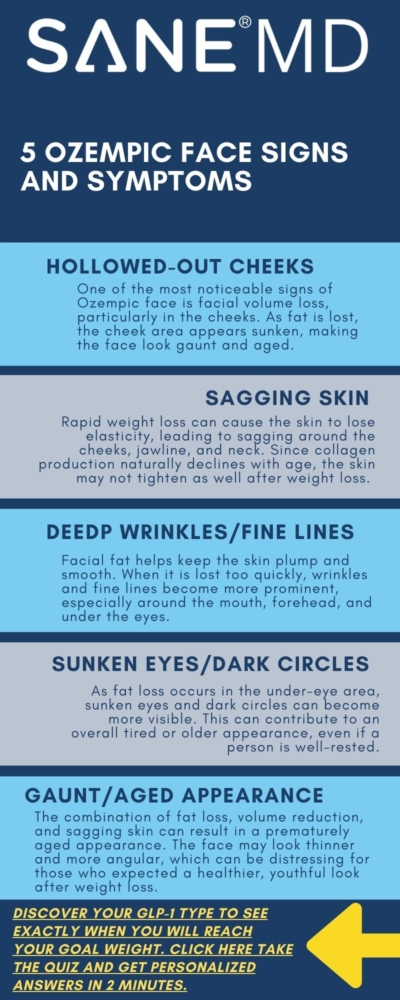Ozempic Face: What it is and How to Prevent it
Dr. Matthew Olesiak, MD, is the Chief Medical Director at SANESolution, a renowned wellness technology company dedicated to providing evidence-based solutions for optimal living. Dr. Olesiak earned his medical degree from the prestigious Jagiellonian University Medical College in Kraków, Poland, where he developed a strong foundation in medicine.
Ozempic face is a term used to describe the noticeable facial changes that occur due to rapid weight loss while taking Ozempic, a GLP-1 agonist prescribed for weight loss and to control blood sugar levels in people managing diabetes.
While effective for losing weight quickly for compatible individuals, Ozempic and similar weight loss medications can lead to fat loss in the face, resulting in sagging skin, hollowed-out cheeks, and an overall aged appearance.
For individuals experiencing significant weight loss, these changes can be distressing, leading many to seek ways to prevent or reverse Ozempic face while continuing to benefit from the medication.
This article explores the causes of Ozempic face, its potential side effects, and how to maintain facial volume through preventive measures and treatments. Take the Ozempic Quiz to learn more about your weight loss drug options.
Key Takeaways
- Ozempic face is caused by the fat loss and volume loss that result from significant weight loss while using GLP-1 agonists like Ozempic.
- Preventive measures include gradual weight loss, strength training, proper skin hydration, and a nutrient-rich diet to improve skin elasticity.
- Treatment options for Ozempic face include dermal fillers, fat transfer, poly-L-lactic acid injections, and plastic surgery to restore facial volume.
What is Ozempic Face?
The term Ozempic face has gained attention as more people turn to GLP-1 agonists like Ozempic for weight loss. While these medications are effective in helping certain individuals lose weight, they can also lead to noticeable changes in facial appearance, including sagging skin, volume loss, and a hollowed-out look.
These changes occur because fat loss is not limited to the body—it also affects the face, leading to reduced facial volume and elasticity.
For many, these effects can be distressing, as the aged appearance caused by rapid weight loss may overshadow the positive health benefits of shedding excess weight. However, understanding why Ozempic face happens and how to prevent and manage it can help individuals maintain a more youthful look while continuing their weight loss journey.
In this article, we explore the causes of Ozempic face, the impact of fat loss and skin elasticity, and the additional factors that contribute to facial changes.
Ozempic Face Overview Chart
| Section | Key Points |
|---|---|
| Ozempic Face Overview | Facial changes due to rapid weight loss; sagging skin, hollowed cheeks. |
| Causes of Ozempic Face | Fat loss in face, reduced skin elasticity, genetic and hydration factors. |
| Prevention Strategies | Gradual weight loss, strength training, skin hydration, balanced diet. |
| Treatment Options | Dermal fillers, PRP therapy, fat transfer, microneedling, surgery. |
| FAQ on Ozempic Face | Effects on face and body, worst side effects, prevention, reversibility. |
Why Does Ozempic Face Happen?
Ozempic and other GLP-1 agonists are highly effective at promoting weight loss, but this process does not always result in a sculpted, healthy-looking appearance. One of the potential side effects of taking Ozempic is facial volume loss, which can make the face appear hollowed-out and aged.
This occurs due to three primary factors: fat loss, reduced skin elasticity, and other contributing factors such as genetics and hydration levels.
1. Fat Loss and Facial Volume Reduction
Ozempic works by controlling blood sugar levels and reducing appetite, leading to significant weight loss over time.
However, fat loss does not occur only in areas where people might want to shed pounds, such as the abdomen or thighs—it also affects the face.
- The fat pads in the face, which provide a full and youthful appearance, begin to shrink as the body loses fat.
- This loss of facial fat results in volume loss, leading to hollowed-out cheeks, sunken eyes, and a gaunt appearance.
- The global facial volume loss is often more pronounced in individuals who lose weight quickly rather than gradually.
Although losing weight has many health benefits, a lack of facial volume can make people appear older or more fatigued than they actually are.
2. Reduced Skin Elasticity
In addition to fat loss, the skin’s ability to maintain firmness is significantly impacted by rapid weight loss.
- Collagen production naturally declines with age, making the skin less resilient to changes in volume.
- When fat is lost quickly, the skin doesn’t have enough time to adjust, leading to loose skin and wrinkles.
- The rate of weight loss plays a significant role—gradual weight loss allows the skin to adapt, whereas losing weight quickly can result in sagging skin and deep facial wrinkles.
The effects of skin elasticity loss can be more noticeable in older patients, as their collagen production is already reduced compared to younger individuals.
3. Other Factors Contributing to Ozempic Face
Beyond fat loss and skin elasticity, other factors also influence how significantly Ozempic face develops.
- Genetics – Some individuals are genetically predisposed to global facial volume loss, meaning they naturally experience a more hollowed-out look when losing weight.
- Age – As people age, collagen production declines, making the skin less elastic and more prone to wrinkles and sagging after substantial weight loss.
- Hydration and Nutrition – Poor skin hydration and insufficient protein intake can further impact facial appearance. Maintaining human skin hydration through dietary water intake and nutrient-rich foods can help improve skin elasticity.
For those who experience severe facial changes while taking Ozempic, addressing these additional factors—such as hydration, collagen support, and gradual weight loss—can help minimize the effects of facial fat loss and maintain a youthful look.
How to Prevent Ozempic Face
While Ozempic face is a common concern among those experiencing significant weight loss, there are several effective strategies to prevent or minimize its effects. The key lies in maintaining skin elasticity, preserving facial volume, and supporting overall skin health.
By losing weight gradually, following a nutrient-rich diet, incorporating strength training, and prioritizing skincare, individuals can minimize sagging skin, wrinkles, and facial volume loss.
Below are four essential steps to help prevent Ozempic face while continuing to benefit from weight loss medications like Ozempic.
1. Opt for Gradual Weight Loss
One of the most effective ways to prevent Ozempic face is to lose weight at a steady, controlled pace.
- Rapid weight loss causes facial fat to deplete too quickly, leaving loose skin that struggles to adjust.
- Gradual weight loss gives the skin’s ability to adapt over time, reducing sagging skin and wrinkles.
- Aiming for a 1–2 pound weight loss per week is ideal for maintaining skin elasticity and minimizing facial changes.
In addition to preventing facial volume loss, slow and steady weight loss also lowers the risk of other side effects, such as hair loss (telogen effluvium), muscle depletion, and weakened skin structure. Eating an Ozempic diet can also help you lose weight gradually, potentially avoiding Ozempic face.
2. Support Skin Health Through Diet
A well-balanced diet plays a significant role in preserving facial volume and skin elasticity. The right nutrients help the skin bounce back, reducing the appearance of wrinkles, sagging skin, and volume loss.
Key dietary components to focus on include:
- Protein – Essential for collagen production, which strengthens skin elasticity and prevents loose skin. Include lean meats, eggs, fish, beans, and dairy in your diet.
- Hyaluronic Acid – Naturally present in the skin, this compound helps maintain hydration and prevent hollowed-out facial features. Consuming bone broth and collagen supplements can support hyaluronic acid levels.
- Dietary Water – Drinking plenty of water enhances human skin hydration, improving the skin’s ability to retain elasticity. Proper hydration can also help prevent dark circles and a gaunt appearance.
- Healthy Fats – Foods rich in omega-3 fatty acids, such as salmon, avocados, and nuts, help improve skin elasticity and reduce facial wrinkles.
- Vitamin C & Antioxidants – These nutrients stimulate collagen production and protect against free radicals that cause premature aging. Found in citrus fruits, berries, and leafy greens, they help keep facial skin firm and youthful.
3. Strength Training to Maintain Facial Fullness
Strength training is crucial for preventing an aged appearance caused by lost volume in the face.
Many people focus only on cardio exercises when trying to lose weight, but resistance training is equally important.
- Maintaining muscle mass helps fill out facial structure, preventing a gaunt appearance.
- Building lean muscle helps slow down the breakdown of collagen and elastin, both of which contribute to facial firmness.
- Strength training exercises—such as weightlifting, bodyweight resistance, and resistance band workouts—support a healthy metabolism while preserving facial volume.
Additionally, facial exercises (such as cheek lifts and jawline movements) may improve blood circulation to the face, promoting a plumper, more youthful look.
4. Skincare and Hydration
A well-planned skincare routine can help prevent facial skin damage and restore volume loss caused by weight loss medications.
- Use Moisturizers with Hyaluronic Acid – This helps improve skin hydration, reducing wrinkles and hollowed-out cheeks.
- Apply Sunscreen Daily – Sun exposure accelerates collagen breakdown, leading to sagging skin and wrinkles. Use broad-spectrum SPF 30+ to protect facial skin from damage.
- Drink Enough Water – Staying hydrated enhances skin elasticity and reduces the risk of sagging facial features.
- Incorporate Retinol & Collagen-Boosting Serums – Retinol stimulates collagen production, while serums with poly-L-lactic acid help maintain facial fullness.
- Consider Preventive Treatments – For those already experiencing volume loss, non-invasive treatments like platelet-rich plasma (PRP), dermal fillers, and autologous fat grafting can restore lost volume before it becomes severe.
Preventing Ozempic face requires a holistic approach that includes gradual weight loss, proper nutrition, resistance training, and skincare.
By supporting skin elasticity and maintaining facial volume, individuals can lose weight without experiencing drastic facial changes.
Taking preventive steps early on can help ensure a youthful appearance even after significant weight loss.
Can Ozempic Face Be Reversed?
For individuals who have already experienced significant facial volume loss due to taking Ozempic, the good news is that Ozempic face can be improved or even reversed through a variety of treatments.
While preventive measures such as gradual weight loss, hydration, and strength training can help minimize facial changes, those who have already developed hollowed-out cheeks, sagging skin, or wrinkles may need non-invasive procedures or surgical options to restore facial fullness.
Several cosmetic treatments can replenish lost volume, stimulate collagen production, and tighten loose skin, helping to bring back a more youthful appearance.
Below, we explore both non-invasive and surgical approaches to reversing the effects of Ozempic face.
1. Non-Invasive Treatments
- Dermal Fillers: Injectables like hyaluronic acid and poly-L-lactic acid restore facial volume and improve skin’s appearance.
- Platelet-Rich Plasma (PRP): Stimulates collagen production to naturally restore facial fullness.
- Microneedling and Laser Treatments: Improve skin elasticity and wrinkles caused by fat loss.
2. Surgical Options
- Fat Transfer/Autologous Fat Grafting: Uses body fat from other areas to restore lost volume in the face.
- Neck Lift and Plastic Surgery: Can tighten loose skin and provide long-term results.
Managing Side Effects of Weight Loss Medications
While taking Ozempic, individuals may experience potential side effects such as hair loss (telogen effluvium), dark circles, and wrinkles due to fat loss. See our comprehensive article for other Ozempic side effects in females.
A holistic approach that includes proper skincare, nutrition, and strength training can help manage these concerns.
Frequently Asked Questions (FAQ) About Ozempic Face
As more people turn to Ozempic and other GLP-1 agonists for weight loss and diabetes management, questions about its side effects—including facial volume loss, sagging skin, and other physical changes—have become more common.
Below, we address some of the most frequently asked questions about Ozempic face, its effects on the body, and how to prevent or reverse it.
1. What does Ozempic do to your face?
Ozempic face refers to the hollowed-out, sagging appearance that some people develop after significant weight loss while taking Ozempic. This happens because weight loss is not selective—it affects facial fat just as much as body fat, leading to facial volume loss, wrinkles, and looser skin.
The effect is more noticeable in older patients or individuals who lose weight quickly, as skin elasticity declines with age.
2. What does Ozempic butt look like?
Similar to Ozempic face, some individuals experience volume loss in the buttocks after significant weight loss with Ozempic. This is sometimes referred to as “Ozempic butt” and occurs when the fat stores in the gluteal area shrink, leading to looser skin, a flattened appearance, and sagging.
Just like with facial fat loss, gradual weight loss, strength training, and collagen support can help minimize these effects.
3. What are the worst side effects of Ozempic?
While Ozempic is FDA-approved and considered safe for many individuals, it does come with potential side effects.
Some of the most severe include:
- Severe nausea and vomiting
- Pancreatitis (inflammation of the pancreas)
- Gallbladder issues, including gallstones
- Kidney problems, especially dehydration-related
- Extreme fatigue and weakness
- Hair loss (telogen effluvium) due to rapid weight loss
- Ozempic eyes that affect vision and eye health
These side effects vary from person to person, and it’s important to consult a doctor if you experience any severe or persistent symptoms while taking Ozempic.
4. What is the biggest side effect of Ozempic?
The most commonly reported side effect of Ozempic is gastrointestinal distress, including nausea, vomiting, diarrhea, and constipation. These symptoms occur because Ozempic slows down digestion, which helps with appetite control but can lead to stomach discomfort. Over time, many users find that their bodies adjust, and the symptoms become less severe.
For those experiencing rapid weight loss, another major side effect is facial volume loss, also known as Ozempic face. This can result in a gaunt appearance, wrinkles, and sagging skin due to fat loss in the face.
5. Is Ozempic face reversible?
Yes, Ozempic face is reversible through both non-invasive treatments and surgical options. Some of the most effective methods include:
- Dermal fillers (such as hyaluronic acid or poly-L-lactic acid) to restore facial volume
- Platelet-rich plasma (PRP) therapy to stimulate collagen production
- Fat transfer/autologous fat grafting, which moves fat from other areas of the body into the face
- Strength training and collagen-rich diets to support skin elasticity
The earlier preventative measures are taken, the easier it is to avoid severe volume loss and sagging skin.
6. How do I avoid Ozempic face?
To prevent Ozempic face, consider the following:
- Lose weight gradually – Avoid losing weight quickly to give your skin time to adjust.
- Stay hydrated – Proper skin hydration improves skin elasticity and reduces sagging.
- Follow a collagen-boosting diet – Consume protein, vitamin C, and hyaluronic acid to support skin’s ability to bounce back.
- Incorporate strength training – Helps preserve muscle mass and prevents a hollowed-out appearance.
- Use skincare with hyaluronic acid and retinol – These ingredients help restore hydration and stimulate collagen production.
Taking these preventative steps can help minimize the facial changes associated with weight loss drugs like Ozempic.
Conclusion
Ozempic face is a common side effect of rapid weight loss caused by GLP-1 agonists. While it can lead to an aged appearance, hollowed-out cheeks, and sagging skin, there are multiple ways to prevent and reverse these effects.
Gradual weight loss, proper hydration, strength training, and medical treatments like facial fillers or fat transfer can help maintain facial volume and skin elasticity, ensuring a more youthful look during the weight loss journey.





